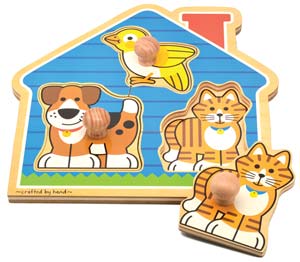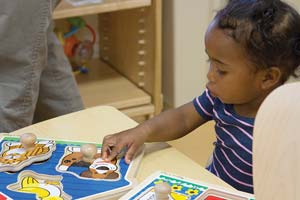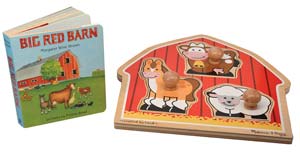Fine motor development
A toddler practices manipulating pieces of a puzzle that has knobs.



Be Prepared: Select a puzzle with 3–4 pieces, a knob on each puzzle piece for a toddler to grasp, and, under each puzzle piece, a picture that is identical to the picture on its respective puzzle piece. Select a puzzle topic that is of interest to the toddler who participates in this activity. The activity description uses an animal puzzle as an example only.
 [Invite a toddler to join you on the floor or at a table to do a puzzle. Clear the work space of other items. Place the completed puzzle fully in front of the toddler. Point to each puzzle piece as you say its name.]
[Invite a toddler to join you on the floor or at a table to do a puzzle. Clear the work space of other items. Place the completed puzzle fully in front of the toddler. Point to each puzzle piece as you say its name.]
Here is a puzzle with pictures of animals. There is a bird, a dog, and a cat.
 Would you please take each of the pieces out of the puzzle?
Would you please take each of the pieces out of the puzzle?
[Encourage the toddler to remove each piece, one at a time. Remove the first piece if you anticipate a demonstration would be helpful. Invite the toddler to place the pieces to the side of the puzzle.
After all puzzle pieces are removed, draw attention to the picture under each piece. Example: “Look, there is another picture of a cat under the puzzle piece!”
Invite the toddler to place the puzzle pieces back in the puzzle board. Begin with a piece of the toddler’s choice. Use the following strategies:
Make a turning gesture with your hand as you say “turn.” (2) “Here are the bird’s feet on the puzzle board. Where are the feet on the piece in your hand? Feet on feet.” (3) “Remember when you felt the bump on the cat’s ear? Try putting the bumps together.”]
[Describe the toddler’s efforts. Example: “You worked hard on a puzzle! You took out the puzzle pieces. Then you put each piece back in the puzzle board. You looked at pictures. You used your fingers to feel parts of the puzzle. You turned some pieces so they fit in the puzzle.”]
Work with puzzles supports different types of skills. Visual discrimination skills were the focus of several prior ELM activity plans aimed at helping toddlers identify a puzzle-piece picture that is the same as a book picture (Block 4, Option 3, Communication/Language) or a picture in the puzzle board (Blocks 6 and 15, Self-Regulation). Fine motor skills, including eye-hand coordination, are the focus of the current activity.
Toddlers are likely to approach the puzzle in different ways. Offer just enough verbal assistance for the toddler to explore the puzzle in relation to his/her interests. Focus on the process of taking apart and putting together a puzzle, not on an outcome of whether all pieces were returned to their appropriate spot. Below are some possible situations:
Extra support
Enrichment
Fine motor development
A toddler manipulates pieces of a chunky puzzle.



Be Prepared: This activity is for a toddler who readily manipulates puzzles that include pieces with knobs (such as in Option 1) and is ready for more challenge. Secure a chunky puzzle with 3–4 pieces and no pictures under its pieces. Select a puzzle topic that is of interest to the toddler who participates in this activity.
 Put the fully assembled puzzle in front of the toddler. Point to each piece and say (or encourage the toddler to say) the name of the pictured item. Encourage the toddler to take out each puzzle piece, one by one, and place the puzzle pieces face up on the table so he/she can see all the pieces. Encourage the toddler to use his/her fingers to hold the puzzle piece, not grip the piece in the palm of his/her hand. After all pieces have been removed, again point to and name each piece.
Put the fully assembled puzzle in front of the toddler. Point to each piece and say (or encourage the toddler to say) the name of the pictured item. Encourage the toddler to take out each puzzle piece, one by one, and place the puzzle pieces face up on the table so he/she can see all the pieces. Encourage the toddler to use his/her fingers to hold the puzzle piece, not grip the piece in the palm of his/her hand. After all pieces have been removed, again point to and name each piece.
Draw attention to the outline of one or more of the puzzle pieces by encouraging the toddler to move his/her finger around the outside of the piece and then around the outside of the corresponding opening on the puzzle board. Offer a demonstration if appropriate. Then encourage the toddler to put the puzzle pieces in the puzzle board. Encourage the toddler to look first at the puzzle piece and then at each of the openings on the puzzle board. Use questions to help the toddler look for an opening that looks like the puzzle piece in his/her hand. Example: Point to an opening and ask whether the toddler thinks the piece in his/her hand would fit in the opening. After a piece has been put in its corresponding opening, point to and describe how a piece and its opening fit together. Invite the toddler to trace the puzzle piece with his/her finger.
Manipulating a chunky puzzle piece is a much different fine motor experience than holding onto the peg of a puzzle piece. Working with a puzzle without the benefit of pictures under the corresponding puzzle piece adds challenge. Promptly offer a puzzle with pegs and pictures if a chunky puzzle without pegs and pictures is too challenging for a toddler to manage.
Emphasize the importance of putting puzzle pieces on the table so it is easy to figure out what they are. Turn upside down a puzzle piece that is on the table so the toddler can see the contrast with right side up. Example: A puzzle piece that shows socks may not be recognized as socks if upside down. Emphasize also the importance of looking at available openings before trying to put a piece in an opening, especially if a toddler rushes to fit a piece into any and all openings. Example: “Let’s look at all the openings. Which opening looks like the piece in your hand?”
Extra support
Enrichment
 Materials Needed: two familiar puzzles, farm puzzle, Big Red Barn by Margaret Wise Brown, no-skid place mat, small toys, sensory table, mailing tube, basket of balls, muffin pans, paper egg cartons, art smock, chubby paintbrush, paint
Materials Needed: two familiar puzzles, farm puzzle, Big Red Barn by Margaret Wise Brown, no-skid place mat, small toys, sensory table, mailing tube, basket of balls, muffin pans, paper egg cartons, art smock, chubby paintbrush, paint
Leave two familiar puzzles on a low table. If using the farm puzzle, display the book Big Red Barn by Margaret Wise Brown. Encourage toddlers to look at the animals on the puzzle and find similar images in the book. Share the book with one or more toddlers. Place a puzzle on a low surface on top of a no-skid place mat.
Provide small toys to manipulate in the sensory table. Arrange play materials to encourage toddlers to revisit some of the skills needed for puzzles. Example: Attach a mailing tube to the wall or furnishings next to a basket of balls that will fit through the tube. Muffin pans and paper egg cartons with small toys or balls provide a satisfying experience for toddlers when the number of items and openings are equal.
Set up a painting activity to foster fine motor development. Offer each toddler one chubby paintbrush and one egg carton. Applying paint to the egg carton is often an appropriately challenging fine motor task. A carton can be repainted after it dries, providing fun for a few days.
Materials Needed: muffin pan, small toys or balls, puzzles, string or lace, large wooden beads, lacing cards, small paintbrushes, watercolors or tempera, jigsaw-type puzzle of 25–50 pieces, cookie sheet or tray
Infants will enjoy using a muffin pan and small toys or balls that fit into each section. Provide a range of puzzles that provide the right amount of challenge to each child in your setting. Other activities to foster small motor development are stringing large wooden beads and lacing cards. School-age children can increase fine motor skills by learning to tie their shoes and zip their own jacket. Offer small paintbrushes and watercolors or tempera to preschool-age and older children. A school-age child may be ready for a jigsaw-type puzzle of 25–50 pieces. Encourage a child to start a puzzle on a cookie sheet or tray so it can be available for multiple days.